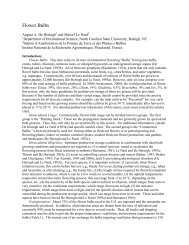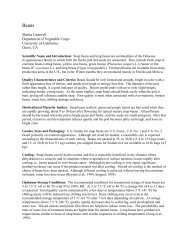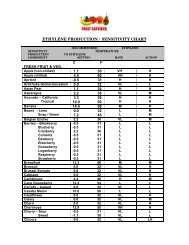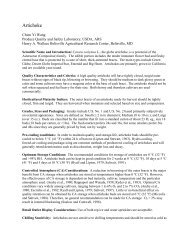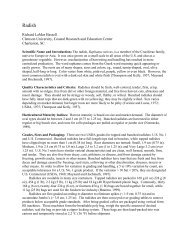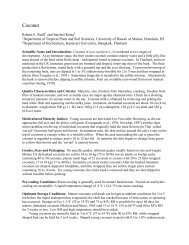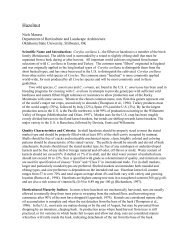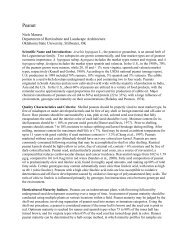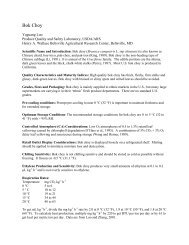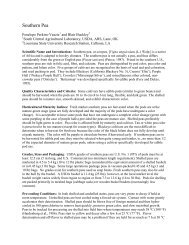Celery
Celery
Celery
You also want an ePaper? Increase the reach of your titles
YUMPU automatically turns print PDFs into web optimized ePapers that Google loves.
Chilling Sensitivity: <strong>Celery</strong> is not chilling sensitive and should be stored as cold as possible without<br />
freezing. The freezing point for celery is -0.5 °C (31.1 °F) (Whiteman, 1957).<br />
Ethylene Production and Sensitivity: <strong>Celery</strong> produces a small amount of ethylene (< 0.1 µL kg -1 h -1 at<br />
20 °C (68 °F). The effect of ethylene is temperature and concentration dependent. <strong>Celery</strong> is not very<br />
sensitive to low concentrations of ethylene when exposure occurs at low temperatures. At temperatures<br />
above 5 °C (41 °F), but more practically 10 °C (50 °F), exposure to > 10 µL L -1 ethylene can result in an<br />
accelerated loss of green color and development of pithiness.<br />
Respiration Rates:<br />
Temperature mg CO 2 kg -1 h -1<br />
0 °C 10 to 20<br />
5 °C 13 to 26<br />
10 °C 20 to 42<br />
15 °C 26 to 54<br />
20 °C 46 to 95<br />
To get mL kg -1 h -1 , divide the mg kg -1 h -1 rate by 2.0 at 0 °C (32 °F), 1.9 at 10 °C (50 °F), and 1.8 at 20 °C<br />
(68 °F). To calculate heat production, multiply mg kg -1 h -1 by 220 to get BTU per ton per day or by 61 to<br />
get kcal per metric ton per day. Data are from Hardenburg et al. (1986).<br />
Physiological Disorders: Pithiness is a major source of quality loss and decreased shelf-life in celery<br />
(Saltveit and Mangrich, 1996). It is characterized by the appearance of whitish regions and air spaces<br />
within the tissues and reduced tissue density, and is caused by the breakdown of the internal pith<br />
parenchyma tissues of the petiole to produce aerenchyma. Pithiness may be induced by pre-harvest<br />
factors, including cold stress, water stress, pre-bolting (seed stalk induction), and root infection. Storage<br />
temperature has a major impact on development of pithiness after pre-harvest induction. Progressive<br />
development of pithiness is delayed by storage at 0 °C (32 °F).<br />
Blackheart is a physiological disorder caused by cell death resulting from calcium deficiency, and<br />
pre-harvest water stress. Internal leaves develop brown discoloration, which eventually becomes deep<br />
black.<br />
Brown check is a disorder related to boron deficiency. It appears as cracks on the inner petiole<br />
surface and is also refereed to as crack stem. The exposed tissues become brown and are susceptible to<br />
pathogen infection and decay.<br />
Crushing or cracking are signs of mechanical damage, and may lead to rapid browning and decay.<br />
Harvesting, packing and handling should be done with great care to prevent damage to the highly<br />
sensitive turgid petioles.<br />
Freezing injury starts at temperatures below -0.5 °C (31.1 °F). Mild freezing causes depressions in<br />
the tissues that subsequently turn brown. Severely frozen tissues develop wilted and water soaked<br />
appearance on thawing.<br />
Postharvest Pathology: The most prominent storage decay is bacteria soft rot (primarily caused by<br />
Pectobacterium or Pseudomonas), gray mold (Botrytis cinerea), and watery soft rot (Sclerotinia spp.).<br />
Keeping storage temperature near 0 °C (32 °F) is important to minimize losses due to postharvest decay.<br />
Controlled atmospheres (1.5% O 2 + 7.5% CO 2 ) have been shown to suppress the growth of Sclerotinia and<br />
watery soft rot (Reys and Smith, 1986; Reys and Smith, 1987). However, careful maintenance of<br />
atmospheric composition is required as celery is sensitive to low O 2 and high CO 2 injury.



